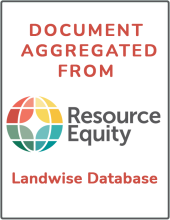Land Library Search
Through our robust search engine, you can search for any item of the over 73,000 highly curated resources in the Land Library.
If you would like to find an overview of what is possible, feel free to peruse the Search Guide.
/ library resources
Showing items 1 through 9 of 26.'Transforming Cities with Transit' explores the complex process of transit and land-use integration in rapidly growing cities in developing countries.
Non-Urbanised Areas (NUAs) are part of agricultural and green infrastructures that provide ecosystem services. Their role is fundamental for the minimization of urban pollution and adaptation to climate change. Like all natural ecosystems, NUAs are endangered by urban sprawl.
Cities are facing considerable challenges resulting from imminent climate change impacts. Urban planning to minimise adverse impacts of climate change at the city level can establish a climate-resilient city. Mitigation strategies to reduce CO₂ emissions would lead to a climate-friendly city.
Urban habitats, particularly wastelands and brownfields, maintain rich biodiversity and offer habitat for many species, even rare and endangered taxa. However, such habitats are also under socio-economic pressures due to redevelopment for housing and industrial uses.
Landscapes in urban areas especially in developing countries are under pressure due to increasing population of urban dwellers and un-directed spread of city boundaries.
Fecal pollution enters coastal waters through multiple routes, many of which originate from land-based activities. Runoff from pervious and impervious land surfaces transports pollutants from land to sea and can cause impairment of coastal ocean waters.
Impervious surfaces are important environmental indicators and are related to many environmental issues, such as water quality, stream health and the urban heat island effect. Therefore, detailed impervious surface information is crucial for urban planning and environment management.
China is the most populated country in the world with slightly more than half of the population is still living in rural areas.



